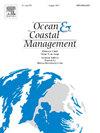Model-based changes in hydro-sediment dynamics induced by estuarine wetlands
IF 4.8
2区 环境科学与生态学
Q1 OCEANOGRAPHY
引用次数: 0
Abstract
Wetlands not only provide abundant resources for human beings, but also play an important role in ecological balance. Wetlands are abundant in the Yangtze River Estuary (CWYE). Due to the influence of vegetation in wetlands, of which the characteristics such as vegetation density are in spatial change, the hydrodynamics and sediment transport in the CWYE are complex. Therefore, three-dimensional numerical simulations in the CWYE were conducted based on Delft3D to analyze the hydro-sediment dynamics affected by vegetation. The traditional sediment module in Delft3D, which determines sediment initiation through the bottom shear stress calculated by flow velocity, was improved considering the influence of wake turbulence caused by vegetation stem on sediment suspension. Results have shown that vegetation reduced the flow velocity which decreased the turbulence, while the wake turbulence caused by vegetation stem increased it. The sediment suspension in wetlands depended on the relationship between the decrease of turbulence caused by decreasing velocity and the increase of turbulence caused by vegetation wake turbulence. The improved model in this paper can be used for hydro-sediment dynamics simulation in coastal wetlands as well as other vegetated areas.
基于模型的河口湿地引起的水沙动态变化
湿地不仅为人类提供了丰富的资源,而且在生态平衡中发挥着重要作用。长江口湿地资源丰富。由于湿地植被的影响,其植被密度等特征在空间上不断变化,因此长江口的水动力和泥沙输运十分复杂。因此,基于 Delft3D 对 CWYE 进行了三维数值模拟,以分析受植被影响的水文泥沙动力学。Delft3D 中的传统沉积模块通过流速计算出的底部剪应力来确定沉积物的起始,考虑到植被茎干引起的唤醒湍流对沉积物悬浮的影响,对该模块进行了改进。结果表明,植被降低了流速,从而减少了湍流,而植被茎干引起的唤醒湍流则增加了湍流。湿地中的泥沙悬浮取决于流速减小引起的湍流减小与植被唤醒湍流引起的湍流增大之间的关系。本文改进的模型可用于滨海湿地和其他植被区的水沙动力学模拟。
本文章由计算机程序翻译,如有差异,请以英文原文为准。
求助全文
约1分钟内获得全文
求助全文
来源期刊

Ocean & Coastal Management
环境科学-海洋学
CiteScore
8.50
自引率
15.20%
发文量
321
审稿时长
60 days
期刊介绍:
Ocean & Coastal Management is the leading international journal dedicated to the study of all aspects of ocean and coastal management from the global to local levels.
We publish rigorously peer-reviewed manuscripts from all disciplines, and inter-/trans-disciplinary and co-designed research, but all submissions must make clear the relevance to management and/or governance issues relevant to the sustainable development and conservation of oceans and coasts.
Comparative studies (from sub-national to trans-national cases, and other management / policy arenas) are encouraged, as are studies that critically assess current management practices and governance approaches. Submissions involving robust analysis, development of theory, and improvement of management practice are especially welcome.
 求助内容:
求助内容: 应助结果提醒方式:
应助结果提醒方式:


